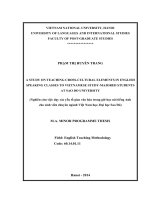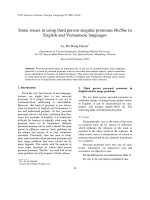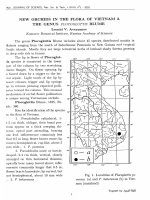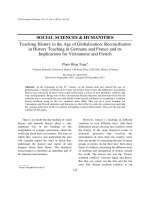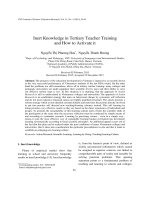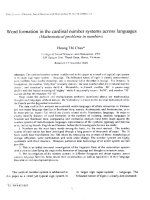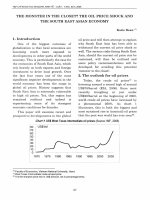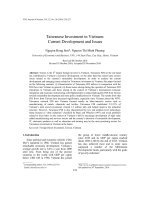DSpace at VNU: Cultural elements in English textbooks Tiếng Anh 3, Tiếng Anh 4, Tiếng Anh 5. A preliminary evaluation
Bạn đang xem bản rút gọn của tài liệu. Xem và tải ngay bản đầy đủ của tài liệu tại đây (225.36 KB, 12 trang )
VIETNAM NATIONAL UNIVERSITY
UNIVERSITY OF LANGUAGE AND INTERNATIONAL STUDIES
DEPARTMENT OF POST GRADUATE
----------
DO THI TO NGA
CULTURAL ELEMENTS IN ENGLISH TEXTBOOKS “TIẾNG
ANH 3”, “TIẾNG ANH 4”, “TIẾNG ANH 5”. A PRELIMINARY
EVALUATION
ĐÁNH GIÁ BƯỚC ĐẦU CÁC YẾU TỐ VĂN HOÁ TRONG SÁCH
GIÁO KHOA “TIẾNG ANH 3”, “TIẾNG ANH 4”, “TIẾNG ANH 5”
M.A. MINOR PROGRAMME THESIS
Field: English linguistics
Code: 60220201
HA NOI, 2015
VIETNAM NATIONAL UNIVERSITY
UNIVERSITY OF LANGUAGE AND INTERNATIONAL STUDIES
DEPARTMENT OF POST GRADUATE
----------
DO THI TO NGA
CULTURAL ELEMENTS IN ENGLISH TEXTBOOKS “TIẾNG
ANH 3”, “TIẾNG ANH 4”, “TIẾNG ANH 5”. A PRELIMINARY
EVALUATION
ĐÁNH GIÁ BƯỚC ĐẦU CÁC YẾU TỐ VĂN HOÁ TRONG SÁCH
GIÁO KHOA “TIẾNG ANH 3”, “TIẾNG ANH 4”, “TIẾNG ANH 5”
M.A. MINOR PROGRAMME THESIS
Field: English linguistics
Code: 60220201
Supervisor: Assoc. Prof. Dr. Nguyen Van Do
HA NOI, 2015
DECLARATION
I hereby state that I, Do Thi To Nga, being a candidate for the Degree of
Master of Arts, accept the requirements of the University relating to the retention
and use of M.A Thesis deposited in the library.
In terms of these conditions, I agree that the origin of my thesis deposited
in the library should be accessible for the purposes of study and research, in
accordance with the normal conditions established by the librarian for the care,
loan or reproduction of the thesis.
Hanoi, July 2015
i
ACKNOWLEGEMENTS
First of all, I would like to express my deep gratitude to Assoc. Prof.
Nguyen Van Do, my supervisor, for thorough reading, critical comments,
invaluable suggestions, various sources of reference and precious corrections on
my writing. Furthermore, I am grateful to his close guidance and generous help,
which have been great encouragement to me during the process of writing up the
thesis.
I, hereby, would like to express my sincere thanks to lecturers of Faculty
of Post Graduate Studies, University of Languages and International Studies of
Vietnam National University, Hanoi for their interesting lessons and suggestions,
which aroused the thesis for this study to be realized.
My appreciation is also extended to the authors of English primary
textbooks Tiếng Anh 3, Tiếng Anh 4, Tiếng Anh 5 for their assistance in data
analysis.
Finally, I would like to thank my family, especially my parents and my
husband for their constant source of love, support and encouragement in times of
difficulty and frustration.
ii
ABSTRACT
The study on “Cultural elements in English textbooks “Tiếng Anh 3”,
“Tiếng Anh 4”, “Tiếng Anh 5”. A preliminary evaluation” is a Minor Programme
Master thesis. It is aimed at examining the cultural elements presented in the
textbooks Tiếng Anh 3, Tiếng Anh 4, Tiếng Anh 5 and suggesting some hints to
improve it in the future.
Based on quantitative methods, the study gives a brief account of how
culture is treated according to the modified checklists designed by two groups of
authors Adaskou, Britten and Fahsi and Cortazzi and Jin, Hirsch et al. The main
findings reveal that both local and non-local cultural references are presented in
the textbooks and among the four cultural dimensions disseminated in the
textbooks, sociological sense is the most dominant dimension. From the findings,
some suggestions are given with the hope that they might be a reliable source of
reference for English teachers and English textbook authors to have general view
about how cultural element is presented in the English primary textbooks and
provide some hints on how to improve it in the future.
iii
iv
PART A. INTRODUCTION
1. RATIONALE
In this 21st century, when the world has become “flat” and closely
integrated, effective communication seems to be one of the crucial concerns. In
order to communicate well and successfully, people need to understand not only
each other’s language, but also each other’s culture. This can open the door to
better international understanding and ensure successful relations.
Language and culture are indivisible elements in the field of language
teaching. According to Peck (2012), “language learning should be more than the
manipulation of syntax and lexicon”. It means that just learning four skills
(speaking, listening, reading and writing) may not lead to the proper
understanding of the hidden meanings of a language. Thanasoulas (2001) also
confirms that “teaching a foreign language is not tantamount to giving a homily
on syntactic structures or learning new vocabulary and expressions, but mainly
incorporates or should incorporate, some cultural elements which are intertwined
with language itself.”
Inevitably, the role of textbooks in English Language Teaching cannot
be underestimated and cannot be separated from language learning in classroom.
They are considered the key component in most TEFL programs, which is
essential for both teachers and learners (Tok, 2010). It is the visible heart of any
English Language program (Sheldon 1988). McGrath (2002) also states that a
textbook is like oil in cooking, it is a useful base ingredient. Cortazzi and Jin
(1999) confirm that: A textbook can be a teacher, a map, a resource, a trainer, an
authority, a de-skiller and an ideology. Hence textbook can be a major source of
cultural elements beside providing linguistic and topical contents ….
1
In accordance with the National Foreign Languages 2020 Project, on 12
August 2010, Ministry of Education and Training issued Decision No 3321/QĐBGDĐT on the Promulgation of the Pilot English Curriculum for Elementary,
and one of its objectives is providing a basic knowledge of English-speaking
countries, their peoples and cultures; as well as fostering pupils’ love and respect
of their own language and culture. Hence, it can be seen clearly that the English
syllabus explicitly emphasizes the development of pupils’ cross-cultural
awareness right at the beginning of learning English.
It may be supposed that, in foreign language textbooks used in primary
schools, whether the teaching of culture is implicit or explicit, cultural aspects of
textbook content as well as the improvement of pupils’ cultural awareness should
be given adequate attention. Since 2011, the Vietnam Education Publishing
House, in line with the Decision No 3321/QĐ-BGDĐT, has introduced a new set
of English textbooks for primary students which provides a good opportunity to
include cultural content into the teaching syllabus, and thus enriching pupils’
cultural knowledge along with developing their four language skills.
2. AIMS OF THE STUDY
The purpose of this study is to analyze and evaluate the cultural elements in three
English textbooks Tiếng Anh 3, Tiếng Anh 4, Tiếng Anh 5 used at primary school
level in Vietnam, compiled by Hoang Van Van et al., published by Vietnam
Education Publishing House. This study is hoped to assist teachers, educators
and English textbook authors to have general view about how cultural element is
presented in English primary textbooks and provide some hints on how to
improve it in the future.
3. RESEARCH QUESTIONS
The concept of “cultural analysis and evaluation” may not attain a unique
understanding and differ in different studies according to different researchers.
2
In this study, the cultural analysis of the textbook is supposed to answer the
following questions:
Research question 1: Are both local culture and non-local culture
disseminated in the English primary textbooks Tiếng Anh 3, Tiếng Anh 4, Tiếng
Anh 5? Which is the most prominent culture presented in the textbooks?
Research question 2: What is the most prominent cultural dimension
presented in the textbooks? How is culture disseminated in the textbooks?
4. METHODS OF THE STUDY
In this study, quantitative method is much resorted to. To collect data for
analysis and evaluate, two checklists focusing on the kinds of cultural categories
are designed. The collected data is be analyzed using comparing and contrasting
techniques to find out the quantitative account of references to different cultural
categories in the textbooks.
5. SCOPE OF THE STUDY
In Vietnam, there exist two official sets of English textbooks for primary
level compiled by Vietnamese authors. They are Let’s learn English 1, Let’s
learn English 2, Let’s learn English 3 and Tiếng Anh 3, Tiếng Anh 4, Tiếng Anh
5. The initial set was first published about 10 years ago and the latter has just
been developed in line with the Project 2020 since 2011. In this study, I just
focus on the contents in the second set.
The study just makes an attempt to conduct a preliminary evaluation about
cultural elements in the primary English textbooks. It is believed that a good
cultural evaluation of a textbook can be made only when the goal of cultural
instructions is clearly stated in the syllabus. In the national primary school
English syllabus there are no appropriate guidelines for cultural instructions
although the stress on pupils’ cross-cultural awareness is emphasized.
3
REFERENCE
1.
Adaskou, K., Britten D. and Fahsi B. (1990). Design decisions on the cultural content
of a secondary English course for Morocco. ELT Journal, 44, (1), pp. 3-10
2.
Canh, Le Van (2014). A Critical Analysis of Moral Values in Vietnam-Produced EFL
Coursebooks for Upper Secondary Schools.
3.
Cortazzi, M & Jin, L. (1999). Cultural Mirrors. Materials and Methods in EFL
Classroom. In E. Hinkel (ed.), Culture in Second Language Teaching and
Learning, Cambridge: Cambridge University Press.
4.
Cunningsworth, A. (1995). Choosing Your Course Book, Oxford: Heinemann.
5.
Dunnet, S. C., Dubin, F. & Lezberg, A. (1986). English Language Teaching from an
Intercultural Perspectives, In Valdes, J. M. (ed.), Culture Bound, Cambridge:
Cambridge University Press.
6.
Duranti, Alessandro (1997). Linguistic anthropology. Cambridge: Cambridge
University Press.
7.
Halverson, R. J. (1985). Culture and vocabulary acquisition: A proposal. Foreign
Language Annals, 18/4, 327-32.
8.
Hien, Do Thi Ngoc (2007). A Cross-Cultural Analysis of English Textbook for Grade
10 and Suggestion of Supplementary Activities for Students’ Cross-Cultural
Awareness. Master thesis. University of Languages and International Studies.
9.
Hu, G. (2002). Potential cultural resistance to pedagogical imports: The case of
communicative language teaching in China, Language, Culture and Curriculum
15/2, 93–105.
10. Hutchinson, T & Torres, E. (1994). The Textbook as Agent of Change. ELT Journal,
48(4), 315-28
11. Kilickaya, F. Guidelines to Evaluate Cultural Content in Textbooks, Retrived from
on September 21st, 2014
12. Kramsch, C. (1998). Language and culture. Oxford: Oxford University Press.
13. Lebrun, J, et.al. (2002). Past and current trends in the analysis of textbooks in a
Quebec context. Curriculum Inquiry, 32 (1), 51-83.
14. Lustig Myron W., Koester Jolene (1999). Interpersonal Communication Across
Cultures. Longman.
15. McDonough, J & Shaw, C. (1993). Materials and methods in ELT: a teacher’s guide.
Oxford: Blackwell Pub.
4
16. McGrath, I (2002) Materials Evaluation and Design for Language Teaching
Edinburgh University Press.
17. Peck, D (2012). Teaching Culture: Beyond Language, Yale-New Haven Teachers
Institute.
18. Pervan, A (2011). The view of culture in two textbooks for English. Master thesis,
University of Malmö.
19. Phê, Hoàng (2004). Từ điển Tiếng Việt, Viện Ngôn ngữ.
20. Ririn, Bernadeta (2012). Cultural elements in Indonesian Language Textbooks.
Indonesia University of Education
21. Rogers Everett M., Steinfatt Thomas M. (1999). Intercultural Communication.
Waveland Press
22. Samovar Larry A, Porter Richard E, Stefani Lisa A (1998). Communication between
cultures. Wadsworth Publishing Company.
23. Sheldon, L. E. (1988). Evaluating ELT textbooks and materials, ELT Journal, 42, pp.
237-246.
24. Sơn, Bùi Hoài (2012), Vietnam, An introduction to national cultural policy, WorldCPInternational
Database
of
Cultural
Policies,
Retrived
from
on September 21st, 2014
25. Stray, C.(1994). Paradigms regained: towards a historical sociology of the textbook.
Journal of Curriculum Studies, 26 (1) 24.
26. Thanasoulas, D. (2001). The Importance Of Teaching Culture In The Foreign
Language
Classroom,
Radical
Pedagogy,
Retrived
from
/>_Culture_in_the_Foreign_Language_Classroom.html on September 21st, 2014
27. Tok, H. (2010). TEFL textbook evaluation: From teachers’ perspectives, Educational
Research and Review, 5 (9), pp. 508-517.
28. Vân, Hoàng Văn (Tổng Chủ biên): Tiếng Anh 3; Tiếng Anh 4; Tiếng Anh 5, Nhà xuất
bản Giáo dục Việt Nam, 2014.
29. Ý, Nguyễn Như, (1998). Đại từ điển Tiếng Việt, Trung tâm ngôn ngữ và văn hóa Việt
Nam, Bộ giáo dục và đào tạo.
30. Yasemin; Agcam, Reyhan (2011). Exploring culture in locally published English ...
education in Turkey - In: CEPS Journal 1.
31. Retrived on September 22nd, 2014.
5
I
